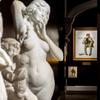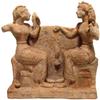Dining with the Victorians: An Aristocratic Indulgence
- December 13, 2017 13:34
M.S. Rau Antiques’ latest exhibition, Aristocracy: Luxury and Leisure in Britain, delves into the aristocratic lifestyle of 19th-century England’s most elite families. While also exploring the history of tea, the centuries-old tradition of the hunting party, and the modern phenomenon of the Great Exhibition, the exhibition also boasts a remarkable dinner spread at the apex of the show. Set with gleaming mother of pearl and silver flatware, golden candelabra and exquisite porcelain, the tablescape offers a momentary glimpse into the long-standing traditions that surround the dinner table.
Dining in the Victorian-era was truly an art form. The economic prosperity of the 19th century catapulted many into the middle and upper classes, and the desire to display one’s wealth and family longevity became central to the social season. Dinner parties in particular became complex rituals - the setting was lit and decorated, extreme attention was given to the most minute details of serving and dining, and food and drink were offered in abundance.
As we enter the holiday season and embark on our own culinary theatre with family, friends and colleagues, it is all the more intriguing to consider what has changed since that golden age of the dinner party – and what endured.
FLATWARE
Traditional dinner parties could boast upwards of 14 courses, and each course required its own separate utensil. Naturally, the extravagance of one’s flatware came to be considered as proportionate to one's wealth. The affluent demanded dining services that could meet every conceivable want and need - from fish forks and cake knives, to asparagus tongs and tomato servers. Those that were especially prized were those used specifically for exotic foods, such as chocolate, oysters and ice cream. Before long, a utensil existed for every food imaginable.
When one considers that just two centuries earlier, dining utensils were generally frowned upon – one’s hands were considered the more acceptable utensil – the array of flatware on the Victorian table is all the more astounding. The grandiose services that reached their heyday in the 19th century do remain in use today, making this dining tradition one with staying power.
THE DINING ROOM
The notion of a formal dining room – one dedicated strictly to the act of eating – first emerged in the early 18th century. By the 19th century, the British elite began to pay great attention to the decoration of this space, where so much time was spent entertaining and socializing. After all, the interactions in this one room could mean all the difference in one’s social position. The dining room was appointed accordingly with massive tables, buffets and sideboards. Walls were covered in elaborate papers, Old Master paintings and gilded mirrors, while every surface held porcelain, silver and glass.
The sideboard was arguably the most important, practical piece in the dining room. Necessities such as extra flatware and knives were often concealed in a sideboard’s urns, while drawers and cabinets provided a convenient hiding place for servants to place soiled dishes after clearing them. A large display surface, often backed by a mirror, also served as the perfect way to display the finest dish of the meal – the host would often carve the meat at the sideboard before it was served.
SERVICE IN STYLE
By the middle of the 19th century, most “civilized” people were eating à la russe, so called because it was purportedly introduced by a Russian ambassador in the early 19th century. It superseded service à la française, where dishes were set out on the table so that guests may serve themselves. Many were reluctant to give up dining à la française, as it allowed the host and hostess to display their wealth and prestige through the size and splendor of the table.
Yet the practicalities of dining à la russe eventually won out by the end of the 19th century. The style dictated that food was to be served individually to each guest, meaning the food arrived hot and there was far less waste. While today some “family-style” meals evoke the sprawling spreads of dining à la française, today’s well-proportioned courses more generally resemble dining à la russe.
FOOD AND BEVERAGE
While the tablescape of the Victorian-era may have been far more opulent than most dinner parties today, the food and drink that was served remains relatively constant. The number of courses, however, has diminished significantly. While three- or four-course meals are the 21st-century norm, the 19th-century meal could range from seven courses to fourteen!
A typical seven-course menu might begin with raw oysters, followed by soup or bouillon and then a fish. The main dish comprised the fourth course, and usually included the meal’s heartier foods, including game meat, potatoes and vegetables. A light salad was presented next, and then a dessert of sweets and fruits. Finally, chocolates and nuts were laid out with the coffee, formally ending the meal.
Coffee was far from the only beverage served. Along with dedicated flatware and plates, each course had its own dedicated beverage of wine, champagne, madeira or port. Sets of crystal drinkware from the 19th century thus grew to include a vessel for every drink imaginable, and these glistening goblets only added to the splendor of the table.
--
For a deeper glimpse into the opulent lifestyle of the 19th-century British elite, don’t miss M.S. Rau Antiques’ latest exhibition Aristocracy: Luxury and Leisure in Britain, which runs through January 20 at M.S. Rau Antiques’ French Quarter Gallery. Click here for more information about the works in this visually appealing, historic exhibition that is truly a once-in-a-lifetime experience.
About M.S. Rau Antiques:
M.S. Rau Antiques has spent over 100 years earning the trust of discerning collectors world-wide. Located in the heart of New Orleans’ historic French Quarter, our peerless gallery houses one of the world’s most extensive and stunning collections of important fine art by artists such as Monet and Rockwell, rare 18th- and 19th-century antiques and breathtaking jewelry, including rare colored diamonds.






100x100_n.jpg)














